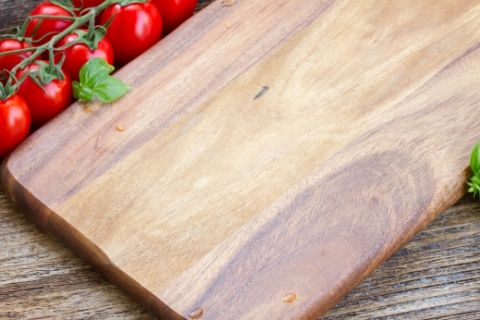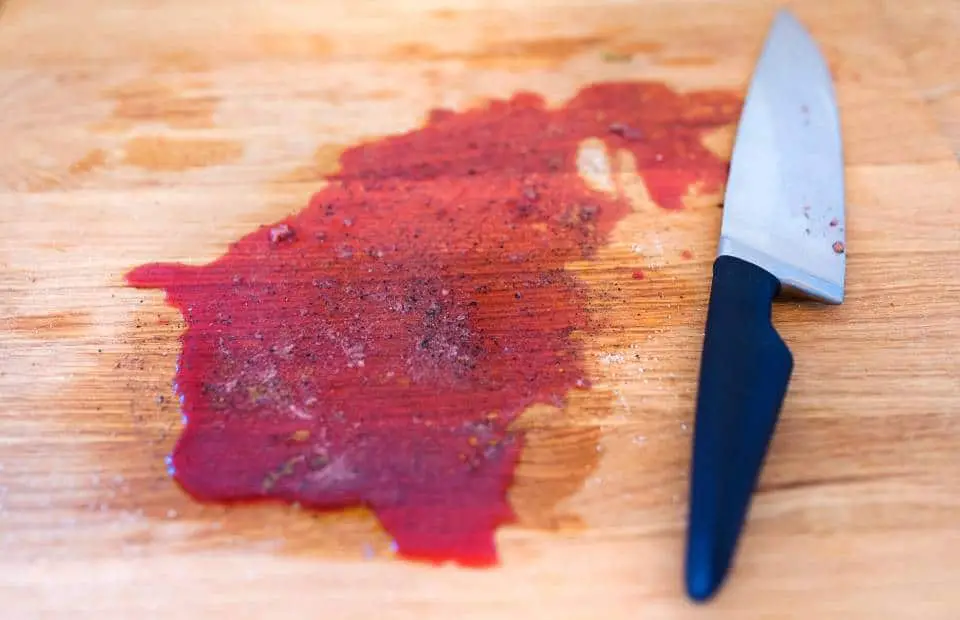Cutting boards come in all shapes and sizes, but the best ones meet the following requirements. Last a long time and don’t stain or dull our knives. I narrowed it down to one but included other great options.
In this I will cover the basics of the different materials. How each one has its own pro’s and con’s. Then show which ones are going to be the most stain resistant.
The Culprits
Certain foods like tomatoes, beets, pomegranates and strawberries are going to cause severe staining. The juices within these are some of the worst culprits. Here is a simple work around you can do to prevent staining.
When you plan to cut these vegetables or fruits, you can either cover your chopping board with something or use a separate plate.
A plate doesn’t stain nearly as bad as a wood or plastic cutting board. When you want to cover your board, you can use a paper towel (not as effective) or plastic wrap.
Alternatively you can consider using plastic cutting board mats. These have become popular because they are inexpensive alternatives to heavy cutting boards.
The best ones are flexible and color coded, or have food icons to help avoid cross contamination.
You can find these economical mats on Amazon here.
Plastic vs Wood
There’s really two most common types of cutting board material. That is plastic boards and wooden ones. Each has its own benefits and drawbacks which can help you decide.
Now the debate has raged on about the differences for many years. Mostly about which type is better for food safety.
Wooden cutting boards have been around the longest. They’re the original and at one time the only kind you could get. You may have one that has been passed down in the family.
Plastic cutting boards arose sometime around the 1950’s or 1960’s. When plastic become more popular. The reason being most likely because they’re cheaper to produce.
Also most believed that they were safer to use than wood ones. Because wood soaks up moisture it must absorb and hold more potential bacteria. This was the idea, but studies have shown this is not true.
That doesn’t mean plastic is worse than wood. As they do each have their benefits.
Plastic cutting boards may be more prevalent today than wood. Rightfully so as they are inexpensive and well made.

Plastic Boards
Pros:
First lets cover the pro’s of using plastic cutting boards. One main benefit is they are easier to clean than wood. Most can be put in the dishwasher if you don’t want to hand wash them.
Plastic boards are also easier on your knives. Because plastic is softer material, when chopping on them you aren’t dulling your knife as quickly.
Cons:
The problem is you will get a lot of knife grooves and scratches. This not only makes cleaner harder. Even using a dishwasher doesn’t guarantee these grooves get cleaned out.
The grooves are where moisture and bacteria get trapped. You end up with more potential chances for bacteria to grow.
So overall plastic does clean and sanitize easier (when in good shape). But might have to be replaced sooner than you’d like.
Thin plastic boards can warp when stored in a leaning position. I noticed this has happened to one of my own. There is a simple solution for this if the warping is minor.
I’ll give that solution along with other helpful tips near the end.
Wood Boards
Pros:
Wooden chopping boards when made right can last a long time. This is because of their durability. A heavily used vintage wooden board can be restored to perfect condition.
Studies have done that show in the long term that wood cutting boards are more sanitary than plastic. This is because wood boards don’t scar as easily as the plastic ones.
The most interesting part is that wood grains which absorb liquids, actually trap and can suffocate bacteria. Especially cutting boards made with hard woods.
Cons:
Now wood boards are not without some disadvantages. One issue you have to deal with is that the harder the board, the more dull your knives will become.
Because there is no give in the surface, especially with hard wood cutting boards. You get longer lasting boards but your knives take a little more abuse.
Wood boards are also harder to clean, as you don’t want to put them in the dishwasher. They aren’t mean to be exposed to a lot of water at one time. As it along with the heat could cause them to warp.
Also there is a extra step you should take to maintain the wood cutting boards. This routine maintenance means there is more work involved with wood boards, but its not hard.
I can share what it is you should do to maintain your wood boards along with helpful tips at the end.

Number One Cutting Board Tip
Overall there both benefits for each type of chopping board. Instead of one single winner. I would recommend having both types.
Here is one thing to take away from the debate. You should use each cutting board separately for different foods.
This means they recommend for example using plastic boards for raw meats. Then use your wood boards for vegetables and other ingredients.
Because plastic is easier and faster to clean (drying is quicker). Using it for raw meats means you can sanitize the board more safely.
Which One Stains More?
Unfortunately both boards can undergo staining, depending on what you cut on them. But one does handle it better and is more stain proof.
Wood boards are going to absorb more liquids but that also means you can clean them much easier. Also darker woods will not show the stains as much.
White plastic cutting boards are going to stain the most out of any cutting board. Mainly because it shows a lot of more than darker colors.
With plastic cutting boards it is also harder to remove the stains.
The Best Cutting Board
Teakhaus Wooden Cutting Board
What I like the most about this cutting board is the wood cut and type. The board is made with end grain wood strips. Which means durability (will last a very long time) and has what people refer to as “self healing’ qualities.
This means the groves made from cutting actually repair naturally. Because fibers in the wood will fill back in.
Best of all and why this post exists is the stain resistant wood. The cutting board is made with teak wood. Which has natural oils in the wood making it one of the least absorbent woods.
Teka wood is actually very difficult if not impossible to stain (with wood stains). This means foods will not stain this cutting board as well.
If you want to buy this cutting board on Amazon, click here
My Second Choice
Another cutting board that I really liked is the Large Teak Wood cutting board. Still made out of teak wood but this one slightly cheaper. Has more features, but is smaller.
You can check out this other stain resistant cutting board here on Amazon.
Both chopping boards are higher in price but you get what you pay for. These are high quality boards that should last a lifetime.
Budget Friendly Option
Both of the cutting boards I mentioned are a little pricey, so I found another third option that is very high quality. It is a extra large bamboo cutting board.
Included are juice catching grooves along the edges. Bamboo as mentioned in the product description is knife friendly.
I really like the size of this cutting board and its hard to beat the price. Under $20 for a large wooden cutting board is a great deal.
If you are interested check out this low cost bamboo cutting board on Amazon.
Helpful Tricks
Simple maintenance goes a long way to prolonging the life of your wooden cutting board. Two necessary steps to take are cleaning and oiling the board.
Oiling a wooden cutting board serves one important purpose. Oil prevents liquids from being absorbed into the wood. This not only stops bacteria growth but also warping.
Warping happens when the board undergoes shrinking and expanding due to moisture exposure.
A wooden cutting board needs oil when it has become dry to the touch. Depending on how often you use your board, this can be done once a month, quarterly or twice a year.
Oiling a board is very easy to do and can be done using mineral oil. Start in a small spot on the board and work your way across the surface/sides. Use a paper or cloth towel to spread the oil.
The key is to use just the right amount, as too much oil and it will not fully absorb. If this happens just wipe off excess oil after letting it dry for 24 hours.
Cleaning a wooden cutting board is done by using baking soda and lemon juice. First dust the baking soda onto the surface of the cutting board. Then pour or squeeze lemon juice over the baking soda.
Use either a paper towel or a lemon half to scrub the surface clean. Then rinse off the board with either water or a wet towel (use warm water for both).
When you go to dry your board make sure to leave it upright. This not only allows more air to dry faster, but the moisture evaporates more rather than continue to soak into the board.

